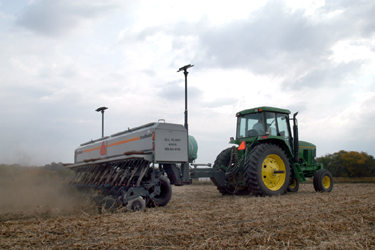
Agricultural News
Winter Wheat Seeded Area Up Slightly with Good Spring Wheat Potential
Fri, 05 Apr 2013 10:49:20 CDT

USW Market Analyst Casey Chumrau writes in the latest Wheat Letter from U.S. Wheat Associates:
The U.S. Department of Agriculture (USDA) provided very few surprises for the world wheat market when it released its annual Prospective Plantings report last week. All wheat seeded area for 2013/14 is expected to reach 56.4 million acres, which if realized, would be 1 percent greater than last year's actual seeded area and up slightly from an earlier estimate. Experience shows, however, that as winter wheat begins its push to maturity, the crop's true potential lies in the hands of Mother Nature.
The well-publicized drought in the southern and central plains has been a source of concern for hard red winter (HRW) wheat prospects. Despite extremely low soil moisture levels last fall, estimated HRW seeded area dropped just 3 percent from 2011/12 to 28.9 million acres. In Kansas, the largest HRW producing state, seeded area is estimated down 2 percent to 9.3 million acres. However, in Texas and Oklahoma, the second and third largest HRW producers respectively, estimated seeded area is unchanged from last year at 5.7 and 5.4 million acres respectively. However, the amount of winter wheat area that may be abandoned this spring is still unknown.
While drought conditions certainly affected HRW seedings, the United States has the advantage of a very large and geographically diverse growing area. Better conditions outside the plains supported increased seedings of every other class of U.S. wheat except durum. USDA expects hard red spring (HRS) wheat area will increase an estimated 3 percent to 12.1 million acres, the most in three years. An estimated 8 percent increase to 6.2 million acres in North Dakota, the largest HRS producing state, accounted for most of the additional acreage. Yet, there is still snow covering much of the potential spring wheat acres and a late spring could cut into the projected increase. Soft white (SW) and hard white (HW) wheat seeding is up an estimated 1 percent to 3.99 million acres, although that total is 5 percent below the five-year average.
The largest by-class increase in estimated seeded area was for soft red winter (SRW), up 19 percent to 9.67 million acres. That is the most since 2008/09. Increases from last year are expected in almost every SRW state, including a record high 960,000 acres in North Carolina.
In contrast, the largest decline among all the U.S. wheat classes will come in durum. USDA estimates durum seeded area will be down 18 percent from last year to 1.75 million acres, which would be the second lowest since 1960/61. Erica Olson, marketing specialist with the North Dakota Wheat Commission, attributed a potential decline to tough competition from spring wheat and other crops. USDA expects that in North Dakota, the country's largest durum producing state, durum seeded area will fall an estimated 18 percent to 1.1 million acres.
"Producers look for a significant price premium at planting time," Olson said, "and they do not see that right now with durum."
When USDA released its first winter wheat Crop Progress report of the spring on April 1, the percentage of all winter wheat rated good to excellent improved by 1 percent to 34 percent. Most wheat growing regions, including a big portion of the drought-stricken plains states, received good moisture in February and March that improved growing conditions. However, the percentage of the crop, mostly HRW, rated poor or very poor also increased 4 percent. Thirty percent of the crop is now rated poor or very poor. Last year at this time, 58 percent of the crop was rated good or excellent while just 12 percent was rated poor to very poor. Winter wheat areas will need additional, timely rain in the next couple months to maintain or improve crop conditions.
The Prospective Plantings report is only an early indication of what the crop year could bring. It is good for buyers to remember that even in years when seeding conditions are not favorable, the United States is capable of producing average or above-average wheat crops. U.S. wheat farmers have once again done their professional and optimistic best to produce an abundant, high-quality crop. From now to harvest, it is Mother Nature's turn.
WebReadyTM Powered by WireReady® NSI
Top Agricultural News
More Headlines...




















